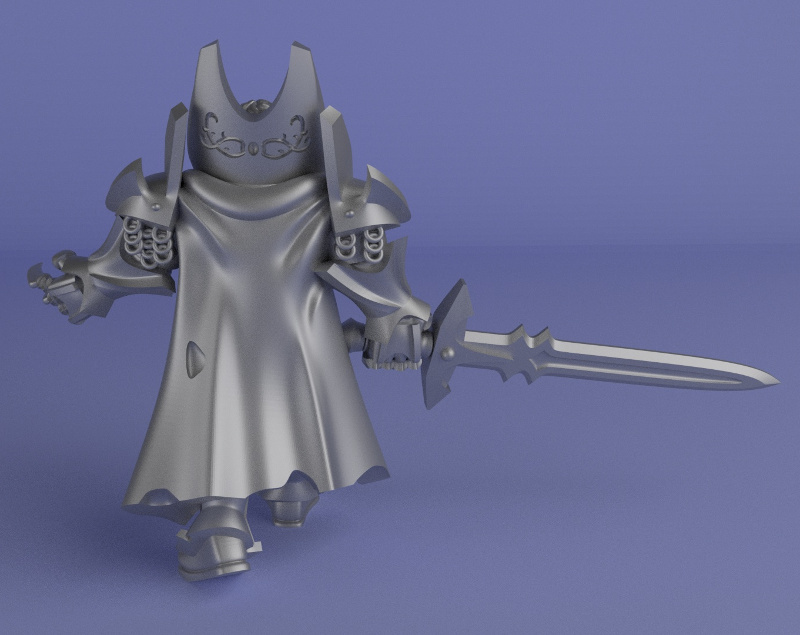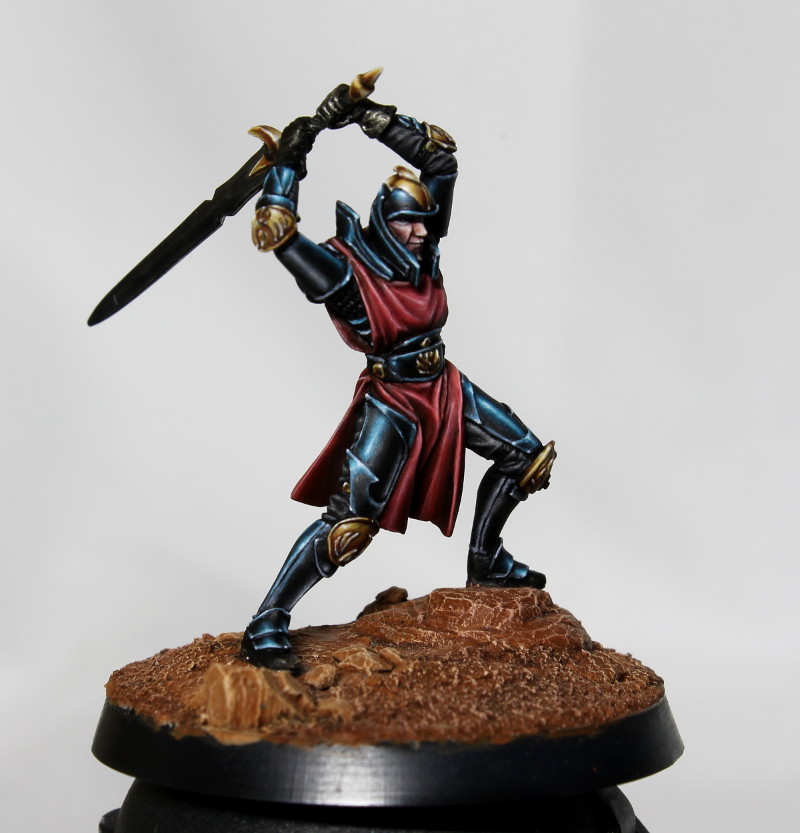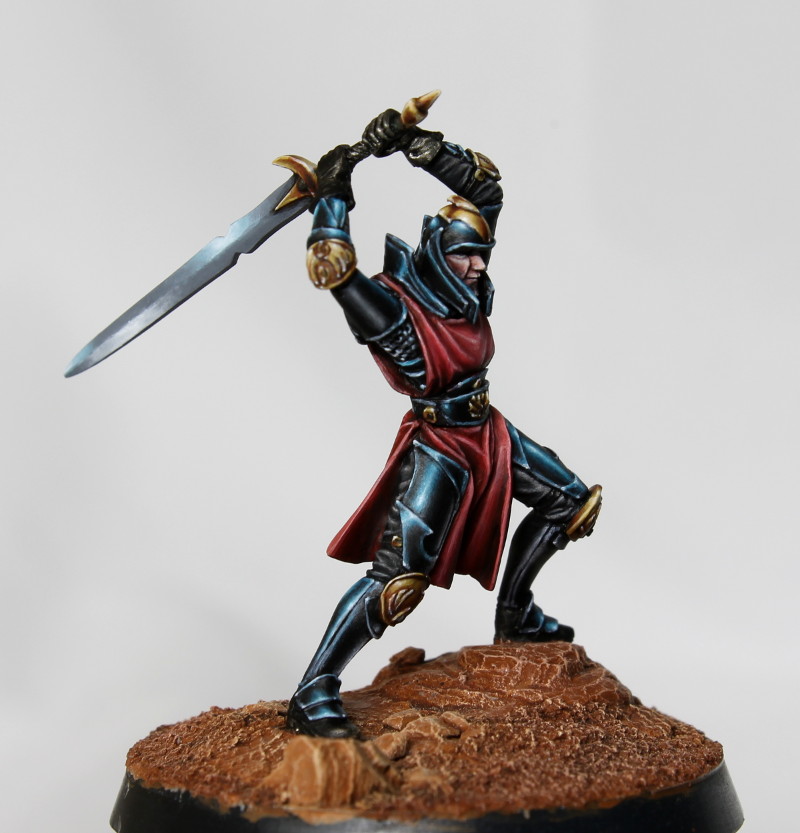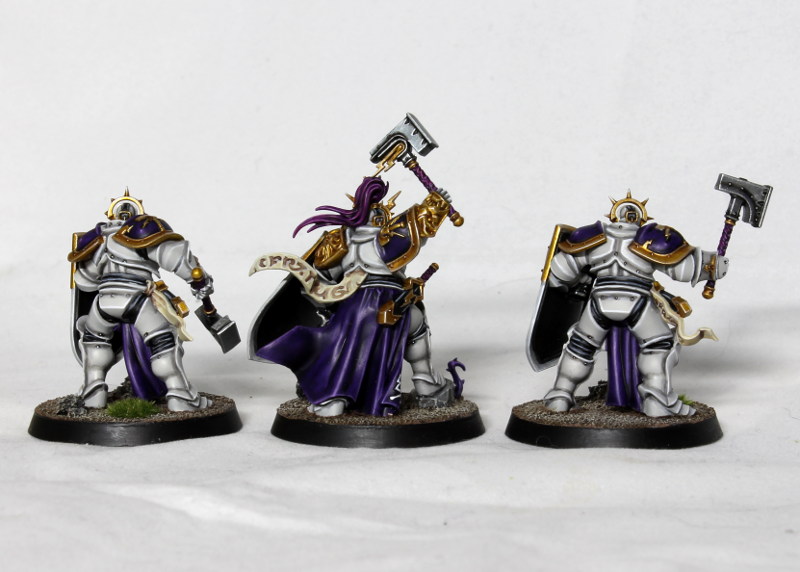If you find this tutorial useful then you may be interested in purchasing more here. Your support will help me to share my techniques!
Part 1 of this tutorial is here.
A GW financial report once spoke of their miniatures as small, jewel like objects of magic and wonder. This description was perhaps wasted on the typical hard-nosed investor, but ‘jewel like’ definitely resonates with me. Anyone who has glanced at my finished work will notice a distinct tendency towards very high contrast pieces with maximum colour saturation. For me this approach gives the most visual impact and is endlessly inspiring.
A key component of my approach miniature painting is shiny armour and it’s the aspect that I receive the most questions about, so in this post I’ll try to explain my technique as I continue to paint the Dark Sword commission.
A blog probably isn’t the best medium for this, but since I lack the capability to make video this will have to do! I’ve made the pictures as big as I can to help illustrate my technique but bear in mind that Dark Sword miniatures are fairly small.
Step 1: Basecoat (and a cheeky bit of cloth)
The most important thing is to keep it smooth! That means thinning the paint down enough so that you don’t introduce any brush marks. Generally speaking, larger areas need the paint to be thinned a little more than small parts. I only thin with water. Using a large brush is a good idea. With each coat I try to avoid having the brush strokes going in the same direction as the previous layer.
Recently I have started to use an airbrush for basecoating when I think it will be significantly quicker. I wouldn’t bother getting it out for anything smaller than a standard GW warhammer figure, and there needs to be large areas of the same colour for me to think it worthwhile.
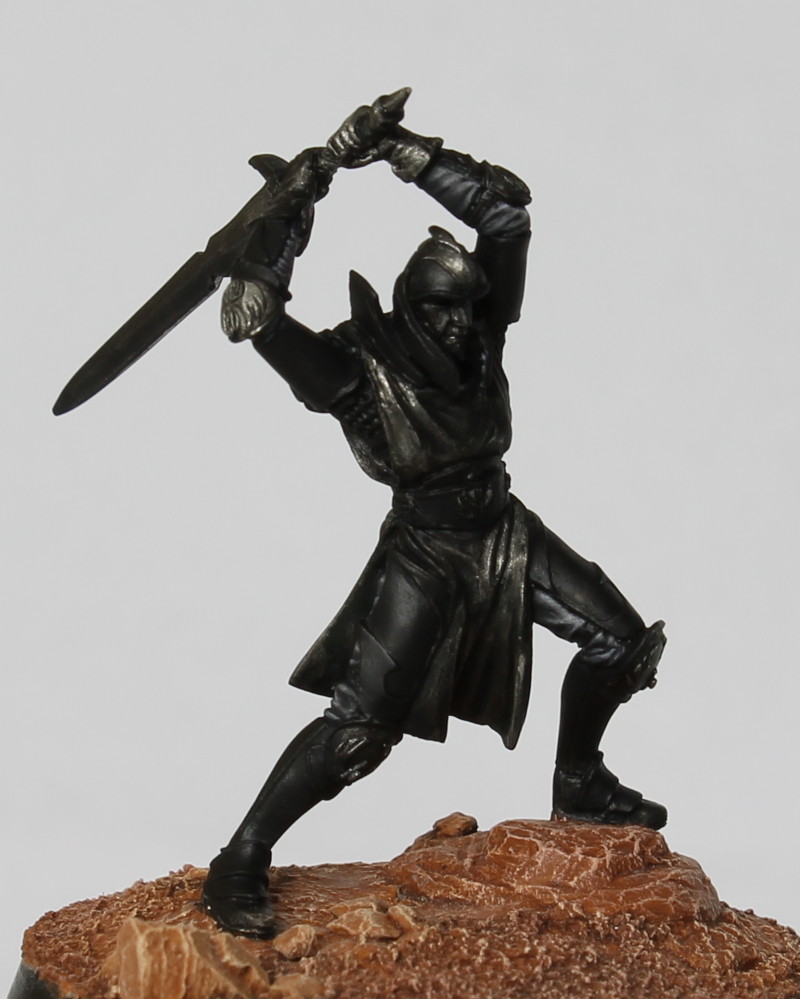
For this figure I had already primed with Vallejo black primer, so I just brushed abaddon black (GW) over the armour and the cloth underneath it. A couple of coats were sufficient in this case.
You can see that I’ve already painted the black cloth that sits under the armour. I highlighted with rosy flesh (reaper) with a little black added to desaturate and reduce the starkness. Then I highlighted with a mix of something like 1:1 rosy flesh and white, keeping this within the previous highlight. Finally I glazed back a little with thin black paint to smooth everything out. I’ll discuss glazing more when I get onto the armour though.
Theory
Before I get onto the technical details, a word on theory. I nearly always paint my miniatures as though they are being illuminated by 5 light sources. 4 of these imaginary light sources come from above the figure – this is a technique that I first saw in an old ‘Eavy Metal masterclass and is now handily explained in this excellent article on Darren Latham’s blog, so it saves me the effort of doing it! The advantage of this approach is that whatever angle you view the miniature from, you will see a reflection from at least 1 light source, and most likely 2.
What about the mysterious fifth light source though? This is a reflection from the ground, so it illuminates the underside of the figure. I like to include this partly to emphasize the glossy nature of the armour and partly because it gives me the opportunity to work another colour in if I want. I take some artistic licence with the placement of this highlight though. If you were to paint it directly underneath the figure then it wouldn’t be visible when the mini is viewed in normal conditions (we are nearly always looking down at miniatures). I therefore cheat and move the highlight upwards so that it becomes visible from a greater range of angles.
Before I apply any paint I usually spend a bit of time at this stage just holding the miniature at various angles under a lamp and observing where the reflections are strongest, as that informs where I’m going to place the highlights.
Step 2: First armour highlight

At last I start to work on highlighting the armour! Looks awful at this stage, doesn’t it?
A few years ago my preferred technique was to build up highlights gradually with many thin layers, each having only a small step in brightness over the last. There’s nothing particularly wrong with this technique and there are some fantastic painters that use it. Personally I now find it a bit too time consuming and consequently my own technique has evolved away from this approach.
Instead I like to apply just a couple of highlights, with a big step in contrast between each layer. In the picture above you can see the result after I’ve applied the first highlight. For the 4 overhead light sources I’ve used a 1:1 mix of thunderhawk blue (GW) and ghost white (reaper), while for the ground reflection I’ve used rainy grey (reaper) with some white added.
At this stage I’m more interested in getting the contrast up than getting the colour saturation. The glazes I use to smooth the blends later will also allow me to introduce more colour.
The key thing when applying this paint is to try and smooth out the edges before it dries so that there’s no sharply defined boundary between the layer and the basecoat. The layer paint is used very thick – I will add just a little touch of water to help with flow. This is because I want to maintain the opacity of the paint. If I were to thin it more then I would need to apply the paint multiple times to get sufficient coverage.
I work on one segment of armour at a time. I put the layer paint down with quite a lot of the thick paint on my brush and then very quickly put the brush in water, dab it on kitchen towel so that it’s just damp, and then run it along the edges of the layer and the basecoat. This allows the paint to flow out from the layer and prevents the formation of a hard edge which would be difficult to disguise later.
Sometimes I’m not quite happy with the results, so it is possible to use the tip of the brush to move the paint around a little and improve the transition. But once the paint starts drying you have to leave it alone or you’ll end up with a rough surface texture and never get a good blend. Keeping the paint smooth is key.
It’s important to say that although this technique is quick, it is certainly not easy! I have experimented with variants of this approach but this way works well for me. Essentially it is two brush blending but rather than using a second damp brush, I re-use the first brush after a quick rinse. Two brush blending is fine but I found that constantly having to worry about whether the second brush was at the right level of dampness was slowing me down.
If the weather is hot then the paint will dry more quickly and things become more difficult. I try not to paint if it’s getting too warm but if I do then I will sometimes pre-wet the surface before putting the layer down. This can either be a very thinned down re-application of the basecoat or pure water. The surface should just be damp rather than flooded. This helps the layer to start flowing before the damp brush is used and buys a little time, but it is extra hassle.
Another option would be to use a bit of retarder in the layer to give more time before it dries. This is something I keep meaning to try but haven’t got around to yet!
Step 3: Second armour highlight

After allowing the previous step to dry fully, I apply the second highlight. I’m getting close to pure white here. Typically I take white and add a small dab of the first highlight paint. I will be knocking the contrast back a bit with the glazing, so I’m deliberately over highlighting a little.
The technique here is exactly the same as in the previous step, but the area of the highlight is smaller. It can be helpful to use a smaller brush at this point. I think I probably used a size 2 for the previous step and a size 0 here.
Step 4: Glazing

Now I have the contrast it’s time to add some colour! Here I have glazed the overhead highlights with a 1:1 mix of thunderhawk blue and sotek green (GW). For glazes I just add a lot of water to the paint. I realise that just saying “a lot” is really unhelpful. The problem is that there’s no set ratio – it depends on the thickness of the paint. It’s something you get more comfortable with eyeballing the more you practice.
If you’re unsure then it’s probably best to err on the side of a little bit too much water, since this just means you’ll have to apply more layers before you get a result you’re happy with. I think that over time I’ve moved towards slightly thicker glazes as I’ve become more practiced and less patient. We’re probably talking about something in the 2 parts water to 1 part paint range, but it definitely varies considerably.
When glazing it’s important to wick almost all the watery paint mix off the brush with kitchen towel or similar before applying it to the miniature, otherwise you’ll get ugly tide marks. Plenty of layers are needed to build up the intensity of the colour and mask the slightly rough transitions. I glaze over the entire highlight area that I’ve applied, but I focus more layers around the edges.
Once I’m happy with the colour intensity I glaze once or twice with the basecoat (black in this case) but only at the extreme edges of the highlighted area. This just neatens things up a little more, since there may be a visible boundary forming between the area that has been glazed with the midtone and the basecoat.
The next step would be to apply final small white highlights, but I elect to leave those until I’ve painted the gold areas, so that I can do both at the same time.
Step 5: Gold NMM

The technique here is very similar to the black armour.
In the first image I’ve applied a basecoat of 1:1 heavy gold brown (VGC) and calthan brown (GW). Heavy gold brown is the best proxy for snakebite leather I’ve found so far. I love snakebite leather but sadly I’ve run out now!
I’ve then highlighted with a 1:1 mix of heavy gold brown and yellowed bone (reaper) and then pure yellowed bone. I’ve used the same highlighting technique as described for the black armour, but not been quite so fastidious about hiding the transitions with the damp brush since the areas are smaller and it will be easier to tidy up later.

I’ve now shaded with dark flesh (GW). Basically I’m putting this anywhere that hasn’t been highlighted, but leaving a region of the basecoat visible. The paint is thinned down enough that it takes about 3 coats to get a fully opaque layer, and I apply it by brushing away from the highlight, so it builds up in the recesses.

A further shade with a 1:1 mix of dark flesh and black. Here I’m working in a much smaller area and concentrating on the recesses.
Step 6: White highlights

Ta da! I apply the white paint fairly thick, but thinned down enough that it takes a couple of applications to make it fully opaque. You can see that I apply the white extremely sparingly.
I’ve also added a small amount of pure black into the deepest recesses on the gold areas. The gold areas aren’t completely finished here, as I intend to go back and work on them a little more later. They’re good enough for now though.
Conclusion
Kudos if you made it this far! I didn’t realise quite how long this post would be when I started it. I hope that it has been useful, and de-mystified my technique a bit. Please feel free to ask any questions in the comments and I’ll do my best to answer.
There will of course be a third (and possibly fourth) part to this article in due course, as we’re not finished with this miniature yet! The eagle-eyed will have noticed that I’ve done nothing with the ground reflections on the black armour after the initial highlight application. And there are plenty more areas that haven’t seen any paint at all yet.
Part 3 is here.


